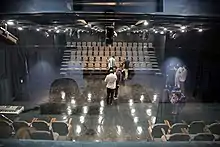Hossein Nuri
Hossein Nuri (also written Hosein Noori or Hussein Nouri) (Persian: حسین نوری, born 1954 in Mashhad) is an Iranian painter, playwright and filmmaker.
Hossein Nuri | |
|---|---|
 Nuri in 2014 | |
| Born | Gholam Hossein Nuri Nekah 1 July 1954 Mashhad, Khorasan, Iran |
| Status | Married |
| Occupation | Painter, Playwright, Filmmaker |
| Spouse(s) | Nadia Maftouni |
| Children | Abolfazl, Mahmoud |
| Relatives | Yaseen (grandson), Hossein (grandson) |
| Website | www |
Early life
Hossein Nuri was born in 1954 in Iran. He lost his father at the age of three and her mother raised him.[1] He showed interest in painting at elementary school.[2] After finishing elementary school in Mashhad, he gained a scholarship to continue studies at Farah Industrial School in Tehran.[3]
Torture and Disability
Farah Industrial School was deeply monitored by SAVAK, Iran's pre-revolution secret service. Along the nation's dissatisfaction with Shah's policies, Nuri wrote a play which was a political satire criticizing the system and defending the human rights. Minutes after the play was staged, it was interrupted by military forces present at the school. Nuri was jailed and tortured severely and he was questioned repetitively mainly to confess if he ever had relations with opposition activists to which Nuri's answer was always negative. After a series of harsh tortures, Nuri lost his ability of moving hands and legs and his internal health started to deteriorate. He was sent to hospital as he was still under control. Finally as the result of fatal damages to Nuri's body, SAVAK stopped its control and Nuri came back to his family who were then residing at Torbat-e Jam. It was there that he sat in a wheelchair and started to hold the brush with his mouth and continued painting.[4]
Marriage
After the revolution, Nuri again decided to write plays and staged them in different cities. In a speech he made for the students of Sharif University of Technology, Nadia Maftouni, who was a student of Applied physics, fell in love with Nuri and proposed to him. Nuri accepted and she left her studies to live with Nuri in Torbat-e Jam. They have two sons; Abolfazl Nuri and Mahmoud Nuri. Later, they moved to Mashhad, and afterwards to Tehran.[5]
Painting Style
In 2004, Nuri introduced his new style in painting in an exhibition he held in Paris. It was based on the painter's intention to create a certain design out of an abstract process. The outcome was a combination of improvisation and calculated design. French painters suggested the name "Reflection" (Réflexion) for the style, which Nuri approved. Nuri does this process with materials such as oil-color and acrylic on large canvas and particularly the large scale of his works is one of his contributions to abstract painting.[6] The use of bright colors and recurrence of butterflies are other characteristics of his style.[7]
Theatrical career

Nuri's theatrical career was revived after the revolution and it wasn't ever secondary to his painting career. In the 80s and 90s He wrote and staged several award-winning plays including The Purgatory Stop, The Crimson Robe, The Last Festival, The Circus, The Company, The Wayfarer, Sweetheart and Intuition.[8] As an established character in Iranian theater history, a theater in city of Mashhad, which is one of Iran's theatrical poles, was named after him as Ustad Hossein Nuri Theater.[9]
Tributes
Ian Linden, Professor of Religious Studies at SOAS who teaches on Christian-Muslim relations, recounts a story from his time in Tehran: "When there was a demonstration in front of the Danish Embassy in protest against the cartoons negatively caricaturing the Prophet Muhammad, an artist, who had lost the use of both arms, had managed while holding the paint brush in his teeth, to create a beautiful painting of Mary. He displayed the image and asked a question: This is our faith. What is yours?" [10]
References
- "گزارشی از نمایشگاه نقاشی آقای حسین نوری و گفتگو با همسر ایشان".
- "La peinture selon Nuri".
- "گزارشی از نمایشگاه نقاشی آقای حسین نوری و گفتگو با همسر ایشان".
- "La peinture selon Nuri".
- "وقتی در زندگی عشق حرف آخر را میزند".
- "هنر بازتاب ظاهر و باطن است".
- "Iran makes Hossein Nuri documentary". Archived from the original on 2016-03-05.
- "Hossein Nuri's Theaterical Career".
- "Ostad Hossein Nuri Theater Opened in Mashhad".
- Hearden, Maura (2014). Mary, for the Love and Glory of God: Essays on Mary and Ecumenism. VA: AuthorHouse. p. 116. ISBN 978-1-4567566-7-3. Retrieved November 6, 2018.